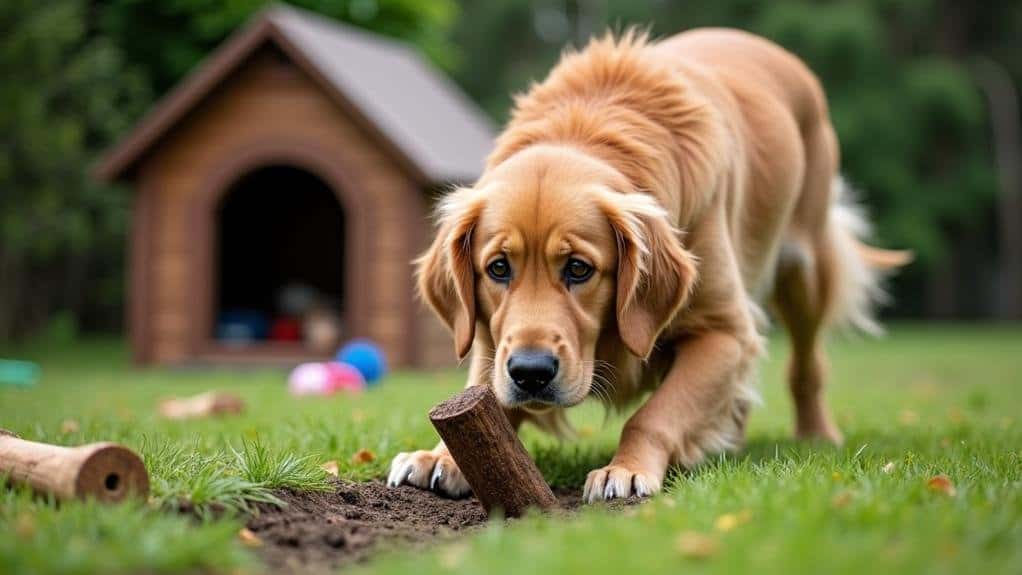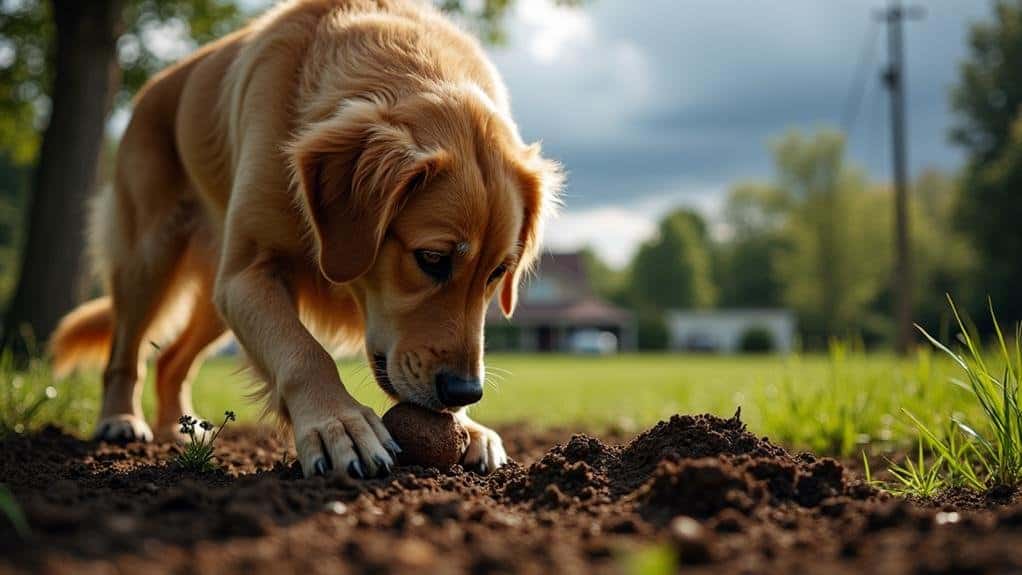Dogs hide their treats due to deeply rooted ancestral instincts inherited from their wolf ancestors. This behavior stems from a survival strategy developed to hoard food during times of scarcity. Even in the comfort of your home, your dog's instinct to protect valuable resources persists. It's a way for them to guard against perceived theft and assert ownership. Anxiety, environmental changes, and dietary factors can also influence this behavior. While it's natural, excessive treat-hiding might signal underlying issues. Understanding the instinct behind this quirk can help you address it effectively and strengthen your bond with your furry friend.
Ancestral Instincts and Survival Strategies

Through the lens of evolution, your dog's habit of hiding treats is deeply rooted in its ancestral past. As descendants of wolves, dogs retain ancestral instincts that drive them to store excess food for future consumption. This behavior, vital for survival in the wild, has been passed down through generations.
The hoarding instinct in your canine companion developed as a significant survival strategy, allowing their ancestors to secure food resources during times of scarcity. When you see your dog hiding food, you're witnessing an adaptive behavior that reflects their wild heritage.
Treat hiding also serves as a protective measure against perceived theft from other animals or pets. This showcases your dog's natural territorial instincts, reinforcing their dominance in a competitive environment.
Resource guarding behaviors, such as hiding treats, signal your dog's instinctual need to establish ownership over valuable items.
Resource Guarding in Modern Pets

Despite living in comfortable homes, many modern pets still exhibit resource guarding behaviors rooted in their wild ancestry. You might notice your dog hiding treats, a behavior that stems from their instinct to protect valuable resources. This resource guarding is particularly common in multi-pet households, where competition for food and toys can trigger anxiety and protective instincts.
Dogs may display various signs of resource guarding, from subtle actions like hiding treats in secluded spots to more overt behaviors such as growling or snapping. These actions are your pet's way of claiming ownership and securing items they deem valuable.
While it's an instinctual behavior, excessive resource guarding can lead to tensions in your home, especially if you have multiple pets.
Understanding the root cause of this behavior is essential for addressing it effectively. By recognizing that your dog's hiding and guarding behaviors are linked to their ancestral survival strategies, you can approach the issue with empathy.
Implementing positive reinforcement training techniques can help reduce your dog's anxiety and resource guarding tendencies, ultimately improving your relationship and creating a more harmonious household.
Anxiety and Environmental Factors

Recognizing anxiety and environmental factors is essential when addressing your dog's treat-hiding behavior. Dogs may resort to hiding treats as a coping mechanism when faced with anxiety triggered by environmental changes. Loud noises or the introduction of new pets can cause stress, leading your furry friend to stash away food for later.
Rescue dogs are particularly susceptible to this behavior due to past experiences that may have created insecurity about food availability. If you've adopted a rescue, be aware that their history might contribute to treat-hiding tendencies.
To help alleviate your dog's anxiety and reduce treat-hiding, establish a consistent feeding schedule. This routine can provide a sense of security and predictability.
Creating a calm environment is also vital, as it promotes relaxation and decreases the likelihood of anxiety-driven behaviors.
If you notice excessive treat-hiding or other signs of distress, it's important to consult your veterinarian. These behavioral issues may require professional intervention to address underlying anxiety.
Overfeeding and Dietary Considerations

Overfeeding and improper dietary choices can greatly contribute to your dog's treat-hiding behavior. When you overfeed your dog, they may develop uncertainty about their next meal, leading to excessive treat hiding as a survival strategy. This instinctual behavior stems from their need to manage hunger between meals, indicating a lack of proper dietary control.
Low-quality dog food that doesn't meet your pet's nutritional needs can exacerbate this issue. If your dog feels unsatisfied after meals, they're more likely to hoard treats for later consumption.
To address this problem, consider implementing regular feedings to regulate your dog's appetite and reduce their urge to hide food. Consulting a veterinarian is essential in establishing an appropriate diet that prevents overfeeding and minimizes treat-hiding behaviors.
They can help you develop a feeding plan that satisfies your dog's nutritional requirements and curbs their instinct to stash food. By providing high-quality meals at consistent times, you'll help your dog feel more secure about their food supply, reducing their need to hide treats as a precautionary measure against perceived scarcity.
Training and Behavior Modification

While addressing dietary concerns is important, effective training and behavior modification techniques play an essential role in curbing treat-hiding habits. Implementing consistent training routines can help reduce treat hiding by setting clear expectations for your dog during playtime and feeding.
You'll want to use positive reinforcement, rewarding your dog for not hiding treats, to reshape their behavior and encourage more desirable actions.
To combat boredom, which can trigger instinctual behavior like treat hiding, engage your dog in regular physical and mental exercises. Puzzle toys and interactive games can provide stimulation and reduce the urge to hide treats.
Gradually reduce the number of treats given and control access to mitigate hoarding instincts.
Understanding your dog's specific triggers for hiding, whether they stem from anxiety or resource guarding, is vital for developing tailored training strategies. By identifying these triggers, you can create a targeted approach to behavior modification.
Frequently Asked Questions
What Does It Mean When Your Dog Hides Treats?
When your dog hides treats, it's tapping into ancient instincts. They're safeguarding resources, managing stress, or simply engaging in natural behavior. It's often normal, but can reflect anxiety or breed-specific traits. Don't worry unless it's excessive.
Why Does My Dog Hide His Treats Under My Pillow?
Your dog hides treats under your pillow because it's a safe, familiar spot. It's instinctual, mimicking burying food. They're guarding resources, seeking comfort, or showing affection by choosing your scent-filled pillow as their secret stash location.
Why Do Dogs Hide When They Don't Feel Good?
When your dog doesn't feel well, they'll hide as an instinctive response to protect themselves. They're feeling vulnerable and seek safety. It's their way of coping with discomfort and avoiding potential threats while they're not at their best.
Are Hiding Treats Good for Dogs?
Hiding treats can be good for your dog. It stimulates their mind, engages natural instincts, and promotes cognitive function. However, you'll want to monitor the behavior to guarantee it doesn't stem from anxiety or stress. Moderation is key.
Conclusion
You've now gained insight into why your furry friend might be hiding treats. It's a mix of ancient instincts and modern-day factors. Remember, this behavior isn't always problematic, but if it's excessive, you'll want to address it. Consider adjusting your dog's diet, environment, and training methods. With patience and understanding, you can help your pup feel more secure and potentially reduce treat-hiding behavior. Keep observing and adapting to your dog's needs.

